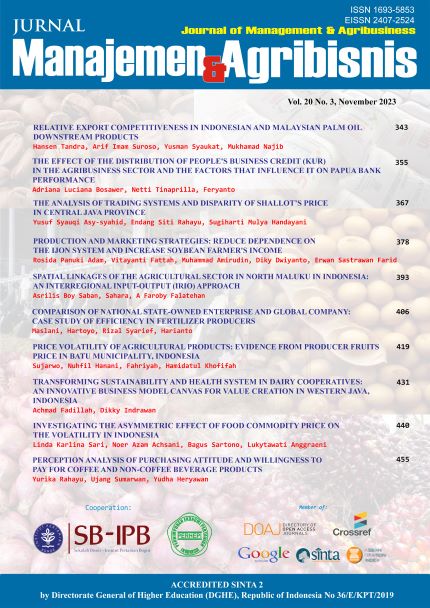The Analysis of Trading Systems and Disparity of Shallot’s Price in Central Java Province
Abstract
The purpose of this research is to analyze the distribution channel patterns of shallots in Central Java, analyze the efficiency, price spread and share margin in the trading channels and disparities of shallots in Central Java, to determine the effect of prices at the consumer level, the amount of consumption, and the amount of shallot production in the short term and long term against price disparity figures. The data analysis method uses ECM (Error Correlation Model). The results of the analysis show that the red onion commodity trading channel pattern in Central Java has 5 different trading system channels. The shortest shallot commodity trade system channel is on channels III and V, while the longest shallot trade system channel is on channels I and IV. The calculation of marketing margins in Central Java is Rp. 18,800 with a trading system efficiency of 1.16, which means that the marketing is efficient, but the value of the farmer's share of shallot farmers in Central Java Province has a value of 56.16 percent, which means that the value is not efficient. The results of the ECM analysis show that the amount of shallot consumption in Central Java Province in the short and long term has a negative and significant effect on the price disparity of shallots at the farmer level in Central Java Province and is in accordance with the theory and hypothesis.
Keywords: shallots, trade system, disparity, efficiency, error correlation model
Authors
Authors who publish with this journal agree to the following terms:
- Authors retain copyright and grant the journal right of first publication with the work simultaneously licensed under a Creative Commons Attribution License that allows others to share the work with an acknowledgement of the work's authorship and initial publication in this journal.
- Authors are able to enter into separate, additional contractual arrangements for the non-exclusive distribution of the journal's published version of the work (e.g., post it to an institutional repository or publish it in a book), with an acknowledgement of its initial publication in this journal.
- Authors are permitted and encouraged to post their work online (e.g., in institutional repositories or on their website) prior to and during the submission process, as it can lead to productive exchanges, as well as earlier and greater citation of published work (See The Effect of Open Access).

